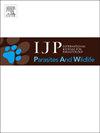野生动物园土壤中作为寄生线虫生物控制剂的食线虫真菌。
IF 2
3区 医学
Q3 ECOLOGY
International Journal for Parasitology-Parasites and Wildlife
Pub Date : 2024-12-12
DOI:10.1016/j.ijppaw.2024.101033
引用次数: 0
摘要
土壤传播的蠕虫感染对围栏内的野生动物构成重大威胁,由于空间有限,这些寄生幼虫更容易传播。噬线虫真菌提供了一个很有希望的解决方案,因为它们可以自然地控制这些线虫。本研究对从非营利性全球生物资源中心ATCC购买的3种噬线虫真菌(Arthrobotrys oligospora, Dactylaria scaphoides, Nematoctonus leiosporus)作为生物防治剂的适宜性进行了测试。采用Baermann-Wetzel方法,从某野生动物园的野猪(Sus scrofa) (n = 10)、小鹿(Dama) (n = 5)和驼鹿(Ovis orientalis musimon) (n = 5) 3种动物中分离到线虫类(圆形线虫sp.)、毛线虫sp.、食道口线虫sp.。在第二步中,真菌与围栏土壤上的寄生虫接触。两种培养基试验表明,食线虫真菌在琼脂平板上的生长效率高于在高压土壤上的生长效率。只有舟形霉在两种培养基上均表现出较好的效果,而其他两种真菌在两种培养基上的差异更为显著。结果表明,这三种噬线虫真菌可以在被感染动物摄入之前减少土壤中的寄生虫。鉴于耐药性的日益发展和使用化学药剂进行土壤处理,这是一个重要的发现,应该在未来进行研究。本文章由计算机程序翻译,如有差异,请以英文原文为准。

Nematophagous fungi as biological control agents of parasitic nematodes in soils of wildlife parks
Infections with soil-transmitted helminths pose a significant threat to wildlife in enclosures, where transmission of these parasitic larvae is easier due to the limited space. Nematophagous fungi offer a promising solution as they can naturally control these nematodes. In this study, three nematophagous fungi (Arthrobotrys oligospora, Dactylaria scaphoides, Nematoctonus leiosporus) purchased from the non-profit global biological resource center ATCC were tested for their suitability as biological control agents. The nematodes Strongyloides sp., Trichostrongylus sp. and Oesophagostomum sp. Were isolated from three animal species: wild boar (Sus scrofa) (n = 10), fallow deer (Dama) (n = 5) and mouflon (Ovis orientalis musimon) (n = 5) from a wildlife park using the Baermann-Wetzel method. In a second step, the fungi were brought into contact with the parasites on the soil of the enclosures. The two media tests showed that the nematophagous fungi were more effective on the agar plate than on the autoclaved soil. Only D. scaphoides showed good efficacy on both media, while the other two fungi showed more marked differences on the two media. The results showed that these three nematophagous fungi can reduce parasites in soil before they are ingested by an infected animal. Given the increasing development of drug resistance and the use of chemical agents for soil treatment, this is an important finding that should be pursued in the future.
求助全文
通过发布文献求助,成功后即可免费获取论文全文。
去求助
来源期刊

International Journal for Parasitology-Parasites and Wildlife
Medicine-Infectious Diseases
CiteScore
3.80
自引率
5.60%
发文量
113
审稿时长
45 days
期刊介绍:
The International Journal for Parasitology: Parasites and Wildlife (IJP-PAW) publishes the results of original research on parasites of all wildlife, invertebrate and vertebrate. This includes free-ranging, wild populations, as well as captive wildlife, semi-domesticated species (e.g. reindeer) and farmed populations of recently domesticated or wild-captured species (e.g. cultured fishes). Articles on all aspects of wildlife parasitology are welcomed including taxonomy, biodiversity and distribution, ecology and epidemiology, population biology and host-parasite relationships. The impact of parasites on the health and conservation of wildlife is seen as an important area covered by the journal especially the potential role of environmental factors, for example climate. Also important to the journal is ''one health'' and the nature of interactions between wildlife, people and domestic animals, including disease emergence and zoonoses.
 求助内容:
求助内容: 应助结果提醒方式:
应助结果提醒方式:


